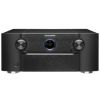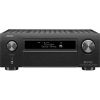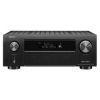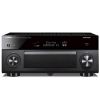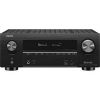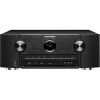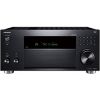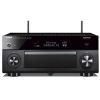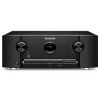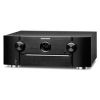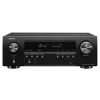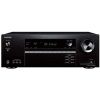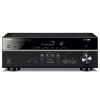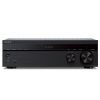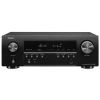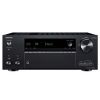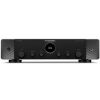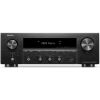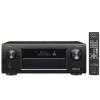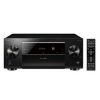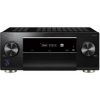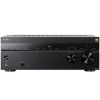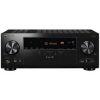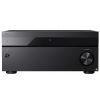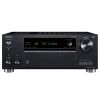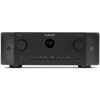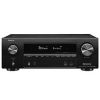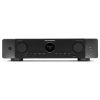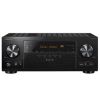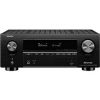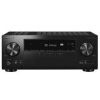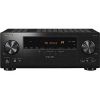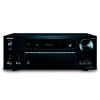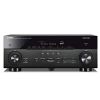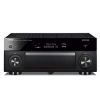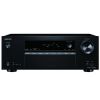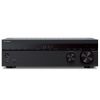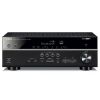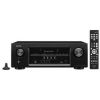| Overall | Amplifier | Audio features | Connectivity | Streaming services | Extensive connection | Multi-room | Additional features | Video features | Multichannel surround | |||
|---|---|---|---|---|---|---|---|---|---|---|---|---|
| Denon AVR-S760H | 7.4 | 7 | 6 | 7 | 9 | 7 | 5 | 10 | 8 | 8 | See price | 279 |
| Onkyo TX-NR5100 | 7.3 | 7 | 9 | 9 | 10 | 6 | 0 | 10 | 8 | 7 | See price | 287 |
| Denon AVR-S750H | 7 | 7 | 6 | 7 | 9 | 7 | 4 | 10 | 6 | 7 | See price | 232 |
| Denon AVR-S660H | 6.7 | 6 | 6 | 7 | 9 | 7 | 0 | 10 | 8 | 8 | See price | 280 |
| Denon AVR-S720W | 6.6 | 7 | 6 | 8 | 7 | 6 | 5 | 8 | 6 | 7 | See price | 88 |
| Yamaha RX-V4A | 6.5 | 6 | 7 | 9 | 10 | 5 | 0 | 7 | 7 | 5 | See price | 269 |
| Cambridge Audio AXR100 | 5.6 | 7 | 6 | 6 | 0 | 5 | 0 | 4 | inapt | inapt | See price | 260 |
| Denon AVR-S540BT | 5.5 | 6 | 6 | 5 | 5 | 6 | 0 | 8 | 6 | 5 | See price | 237 |
| Denon AVR-X540BT | 5.3 | 6 | 6 | 6 | 5 | 6 | 0 | 8 | 6 | 5 | See price | 142 |
| Sony STR-DH790 | 5.3 | 7 | 8 | 6 | 0 | 7 | 0 | 6 | 7 | 7 | See price | 113 |
Movie and music lovers know that sound quality is at the top of the list of criteria that allow us to enjoy great music or a good movie. Sound quality is highly dependent on the speakers used, as well as on the amplifier and its quality. Even when using high-quality speakers, they are not able to restore all the nuances of the audio signal, so it is extremely important to choose the best av receiver under 500 to listen to music.
It is for these reasons that we decided to choose the best Hi-Fi amplifiers and tell you about the specifics of each model, the differences between them in our receiver review, and, thus, allow you to easily choose the most suitable Hi-Fi amplifier for you.
The list you are going to observe is made in accordance with models’ brands. So here we have the section of models of one brand then goes the next and so on. Moreover, we underlined the best model of each brand in order for you to easily pick the best av receiver under 500 for your needs.
The preference was given to new models, but if the older one is still relevant and deserves attention, then it is presented too.
Onkyo
Onkyo TX-NR585
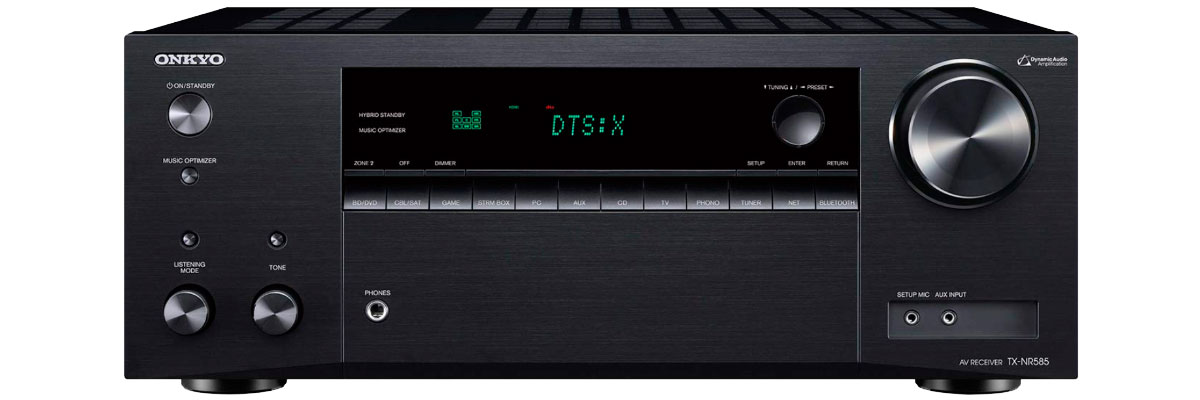
Looking for the best av receiver under 500, I have noted the conservatism in the design of AV receivers. The Onkyo TX-NR585 looks just like other devices of this class. Each of them is a black box with buttons and handles on the front panel. Keeping the front panel design means that the device has one of my favorite features with any AV receiver - direct input selection switches. Like many other users, I tend to lose the remote control from time to time. Therefore I find it very valuable to select the right signal source with a simple click on the button on the front panel.
Speaking about ease of use, it is essential to note a simple and reliable remote control, as well as the color menus with High Definition resolution.
Onkyo TX-NR585 develops 80W on each of the seven channels and has a wide range of functions. The latter includes support for the Dolby Atmos and DTS:X formats, as well as an acoustic output to Zone 2. This can be helpful if you intend to sound another room with a pair of speakers.
Onkyo TX-NR585 supports a substantial list of streaming technologies, including Chromecast, Spotify Connect, DTS Play-Fi, AirPlay, and Bluetooth. This model also has proprietary FlareConnect technology with audio mirroring, which will allow you to transmit the signal from the source of one room to others. This can be useful, for instance, for listening to music from a vinyl player or other analog sources. 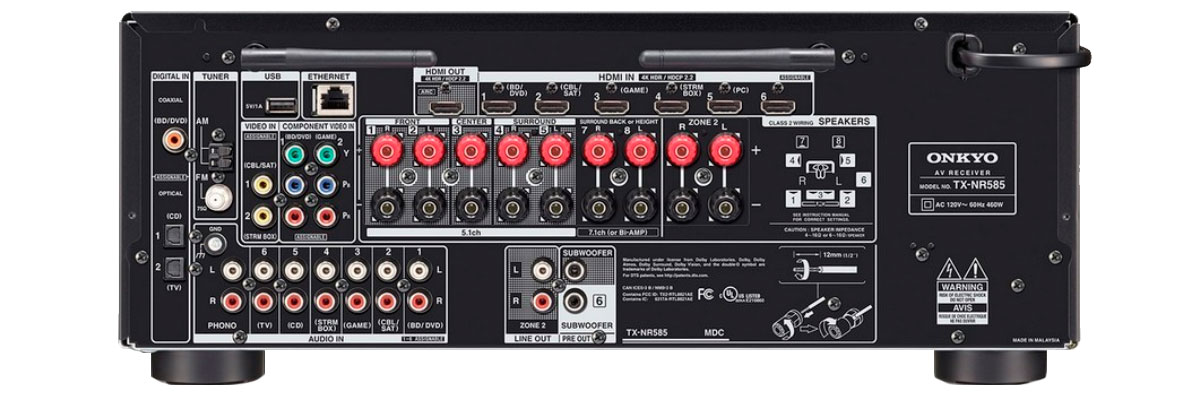
Of all these streaming music transmission systems, the most user-friendly is Chromecast. However, the days of one streaming technology suitable for everyone have passed, and even Sonos now supports third-party applications like Spotify. Play-Fi has the support of many manufacturers of AV-equipment but requires the use of a special mobile application.
Compared to the Yamaha RX-V485, which has only four HDMI inputs, the Onkyo model has six of them. The possibility of transmitting 4K videos, including HDR10 and Dolby Vision. The Onkyo TX-NR585 rear panel also has component and composite video inputs, six analog line inputs, Phono, two optical and one coaxial input, as well as a USB port.
The Onkyo TX-NR585 performed excellently through the acoustics, without too much sharpness at mid frequencies or highs. The tonal balance of the system was great for listening to music.
The dynamics of sound and the atmosphere of the scene were better than when listening through Denon AVR740H. In addition, the Onkyo TX-NR585 could play music through AirPlay and display on a TV screen, which the Denon AV receiver could not.
Key specs
- Channels: 7.2
- Stereo power (RMS), W/Ohm: 80/8, 170/6
- Full specs
Pros
- Set up is easy and intuitive due to good on-screen menu
- Constant firmware updates
Cons
- The CEC feature works badly. It does not turn on TV with a receiver
- There is a little delay in music playback via Bluetooth
Onkyo TX-NR787
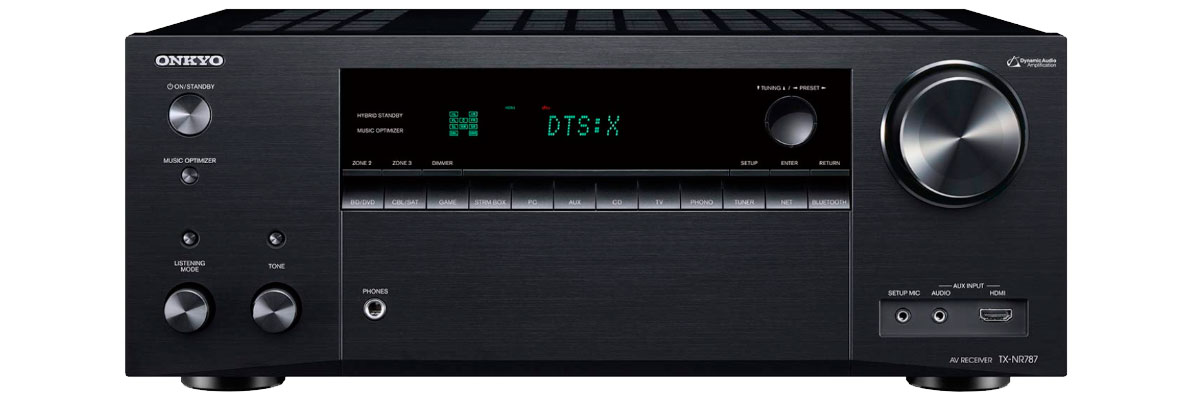
Onkyo TX-NR787 is a top home theater receiver in the NR receiver line.
This modern featured with a powerful amplifier that produces 100 watts per channel at 8 ohms and bangs up-to-date surround processing. And the THX Selected certification confirms the quality of the components and the sound produced.
Of the surround sound formats, the receiver supports DTS: X and Dolby Atmos in configurations 5.2.4 or 7.2.2, and also have the upmix functionality of Dolby Surround and DTS Neural: X. 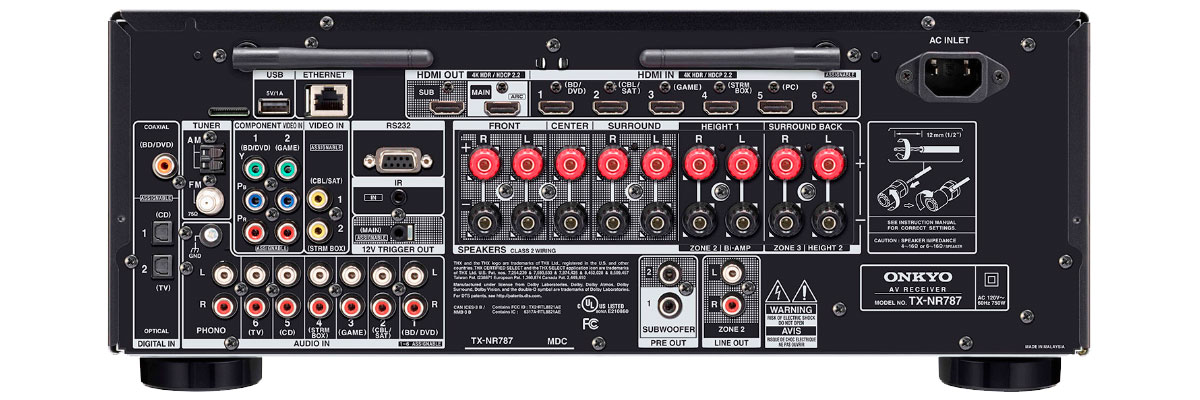
The receiver, like most top AV receivers under 500, works with 4K-signal in HDR (HDR10, HLG, Dolby Vision) and 60 frames per second with a color palette BT.2020, space 4: 4: 4, supports 24-bit video stream, equipped with 6 HDMI inputs with support for HDCP 2.2 on the rear panel (one on the front does not support HDR) and two outputs. Separate DACs are provided for the second and third zones. Also for the second zone provides a linear output.
In terms of network capabilities, the receiver is also in order. The device is capable of playing music from streaming services Amazon Music, Tidal, TuneIn, Deezer, Pandora, and Spotify, as well as connected via Bluetooth, AirPlay, DTS Play-Fi, FlareConnect and Chromecast devices.
Key specs
- Channels: 9.2
- Stereo power (RMS), W/Ohm: 100/8, 220/6
- Official website
- Full specs
Pros
- The receiver supports the Google Assistant voice assistant
- Hooking up the TX-NR787 does not cause any problems
- The onscreen GUI is intuitive enough to make navigating through the setup easy
Cons
- The TX-NR787 cannot be used as a preamp because it does not have analog multi-channel outputs
Yamaha
Yamaha RX-V585

Yamaha RX-V585 is a 7.2-channel AV receiver with support for Dolby Atmos or DTS: X surround formats, the essence of which is that there are no soundtracks in the film and the entire multi-channel sound is “collected” directly in the receiver itself. But, as already mentioned, there is practically no content in these formats yet, and this feature is likely to be useful for the future.
Connecting to your home network is available both over cable via Ethernet and over Wi-Fi. The receiver also has a built-in Bluetooth adapter for the ability to play music from various mobile gadgets without the help of wires. If this is not enough, then using the Airplay and Wireless Direct protocols, you can directly control the receiver and play music on smartphones and tablets running iOS and Android via Wi-Fi. In general, everything is traditional here, and these network capabilities practically do not differ from the specified predecessor Yamaha RX-V583. But, as they say, nothing more is needed, this functionality fully covers all the necessary features in the reproduction of content.
Externally, the Yamaha RX-V585 AV receiver is practically no different from its predecessors, and for example, if you take the last year’s model of the Yamaha RX-V583 receiver, they generally look like two drops of water. It is traditionally made in two colors: black and silver metallic. 
The location of the buttons on the receiver is convenient, it’s not difficult to figure out their purpose, but as a rule, the buttons on the receiver are usually not used much. Basically, all the steps for setting up and controlling are performed using the remote control. It also has not practically changed, and in principle, this is good since, in this form, it remains as convenient and familiar as possible for use.
The rear panel of the bidder to be the best receiver under 500 has a sufficient package of various switching for connections: 4 inputs and 1 HDMI output (HDCP2.2, HDR10 / Dolby Vision / HLG and BT.2020 compatible). Three composite video inputs and one output, two coaxial digital inputs, and one optical. Also available are three analog stereo inputs on RCA connectors, output to an active subwoofer, and an Ethernet RJ45 network port.
The sound of the Yamaha RX-V585 provides Burr-Brown DACs with a sufficiently powerful amplifier delivering up to 145 watts, which is enough to fill a room with an average room of 45-50 square meters in scale and impressive dynamics when watching movies. At least in our room of 48 square meters, we did not notice a lack of sound power in the system, the sound picture was dynamic and consistent, and we did not twist the volume level to values close to maximum. Measurements showed that at loads close to maximum, the amplifier without distortion produces up to 110 watts of power with one channel used (8 ohms), and 145 watts with a nominal resistance of 4 ohms. Non-linear distortions at various loads are within the permissible range of 0.02% over a wide frequency range.
Key specs
- Channels: 7.2
- Stereo power (RMS), W/Ohm: 80/8, 145/6
- Official website
- Full specs
Pros
- It doesn’t sound good at all - but much better
- A good set of streaming functions and the ability to easily connect wireless rear speakers are additional advantages of this model
Cons
- I wish output power could be bigger
- The AV receiver has only four HDMI inputs and is not compatible with Google Chromecast and Dolby Atmos
Yamaha RX-V485
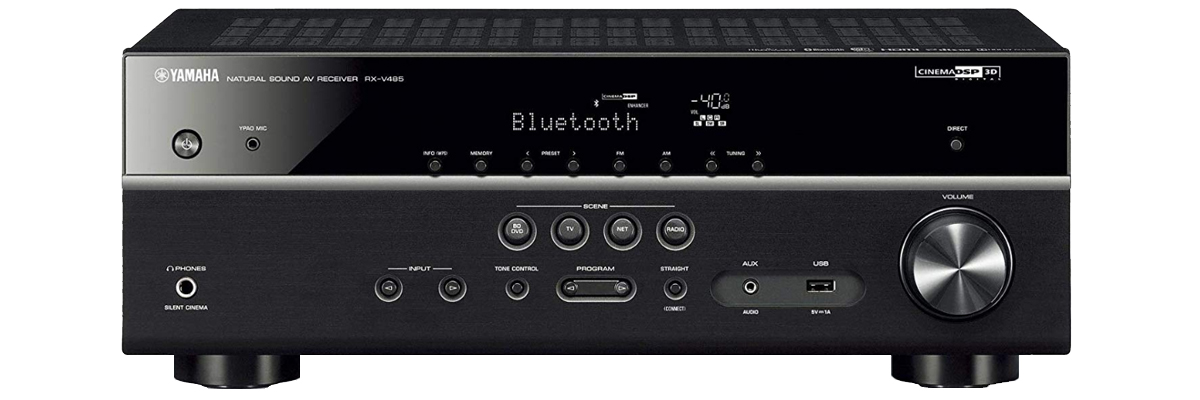
Yamaha RX-V485 is a 5.1 model, capable of delivering up to 145 watts per channel at 8 ohms and a total harmonic distortion of 0.09%, which is inaudible. It stands out from the competition in this comparison with a higher-performance 32-bit / 384-kHz DAC, 5GHz WiFi support, and compatibility with Yamaha MusicCast surround speakers and wireless subwoofers support and makes good competition for all receivers in these best receivers under 500 comparison
Although the entry-level model, it benefits from discrete amplification with Total Purity Concept technology and a properly sized power supply to handle bass-reflex speakers with multiple bass speakers. Yamaha works on Dolby processors to deliver great sound in all circumstances. Dolby Audio technology offers, for example, an improved loudness mode, which achieves low-volume balanced sound, as well as a Dolby Digital and Dolby TrueHD multichannel formats, are supported. In addition, the Yamaha RX-V485 amplifier is compatible with DTS, DTS 24/96 and DTS HD Master Audio formats. automatic volume mode, which intelligently reduces dynamic gaps.
The amplifier also supports Ultra HD video in Dolby Vision HDR format, as well as BT.2020 color space. The HDMI 2.0 controller is, of course, CEC compatible, for control of the amp. The ARC protocol, for the transmission of sound from the TV, is supported, unlike some competitors. 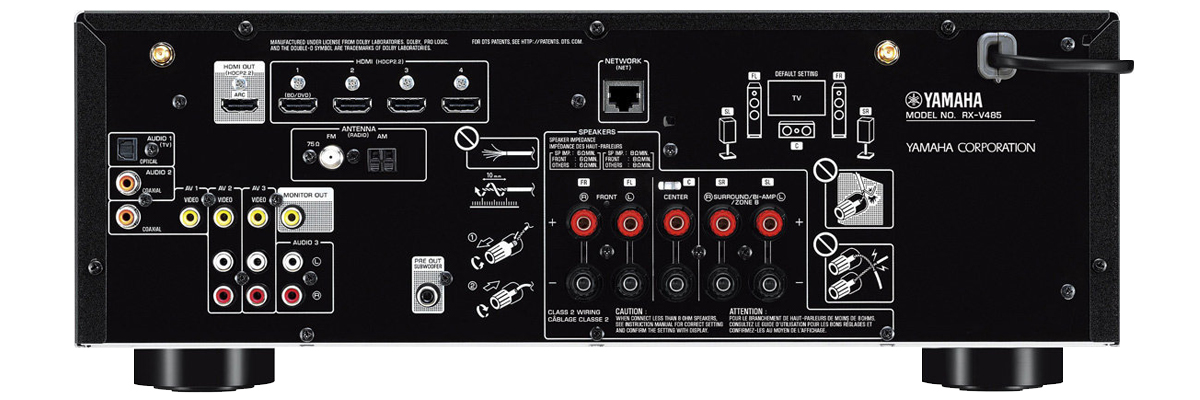
Ethernet and WiFi network controllers allow it to network home and the Internet, for listening to online music services (Deezer, Spotify) and streaming from a computer or smartphone (DLNA, Apple AirPlay). In addition, the Yamaha RX-V485 can be controlled with a mobile application for iOS and Android.
There is a USB port on the front that is compatible with the iPhone and iPods. This port can also accommodate a USB key to read FLAC audio files, Apple Lossless or DSD for example. Also, the integrated Bluetooth controller ensures wireless playback from any smartphone or tablet, as well as from computers. Bluetooth SBC and AAC codecs are supported.
Key specs
- Channels: 5.1
- Stereo power (RMS), W/Ohm: 80/8, 145/6
- Official website
- Full specs
Pros
- With ESS Sabre DACs users get a little more detail and clear sound than with the standard Yamaha DACs
- Yamaha RX-V485 also supports the Spotify Connect protocol, for direct control from the Spotify mobile and desktop application
Cons
- Without a mobile application, a detailed configuration and precise control of the receiver are not possible. But having multiple apps with similar names on Google Play is confusing
- The Net Radio feature has a serious software design flaw - during the operation, it displays the “Access Error” message, which completely stops the function and is solved by rebooting the receiver
- In the user manual, the setup is not described exactly and there are many features not described
Yamaha RX-V683
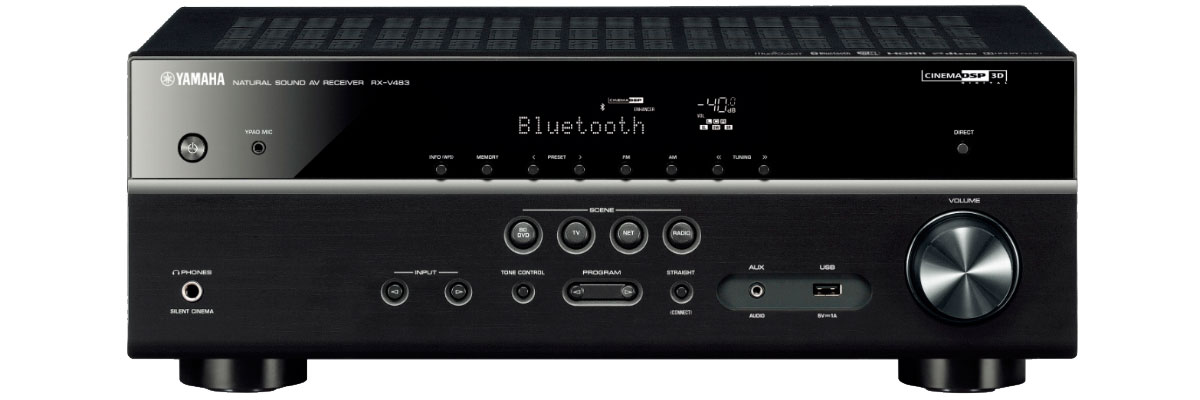
The Yamaha RX-V683 is the top of the mid-budget range. This amp 7.2 adopts a discrete amplification, capable of providing a substantial power reserve, which makes it the best av receiver under 500. It also has a low jitter circuitry (Low Jitter Circuitry), for very fine reproduction of digital audio streams. And, the conversion of digital audio signals is provided by DACs Burr-Brown 32bits / 384kHz. Powerful, the Yamaha RXV683 develops 90 watts per channel at 8 Ohms, embeds the famous DSP Virtual Cinema Front owner (to recreate a surround sound to from the two front speakers), and the most popular HD audio decoders of the moment (DTS: X, Atmos, Dolby TrueHD, DTS HD Master Audio).
There are HDMI 2.0b sockets that are all obedience HDCP 2.2, compatible Rec.2020 and 2 160p up to 4: 4: 4. In the same way, HDR10, HDR HLG, and HDR Dolby Vision compatibility are on the program. Finally, still in terms of specifications, the Yamaha RX-V683 enjoys a DAC Burr-Brown 192 kHz / 24-bit on all channels, displays a total harmonic distortion of 0.06% for a signal-to-noise ratio greater than 110 dB and a frequency response of 10 Hz to 100 kilohertz.
The Yamaha RX-V683 is also very versatile. Connected to the network via Wi-Fi or Ethernet, it can be integrated into the MusicCast ecosystem and have access to any content, such as streaming services (Spotify, Deezer, Qobuz) or web radio. You can also send music wirelessly via Airplay or Bluetooth. 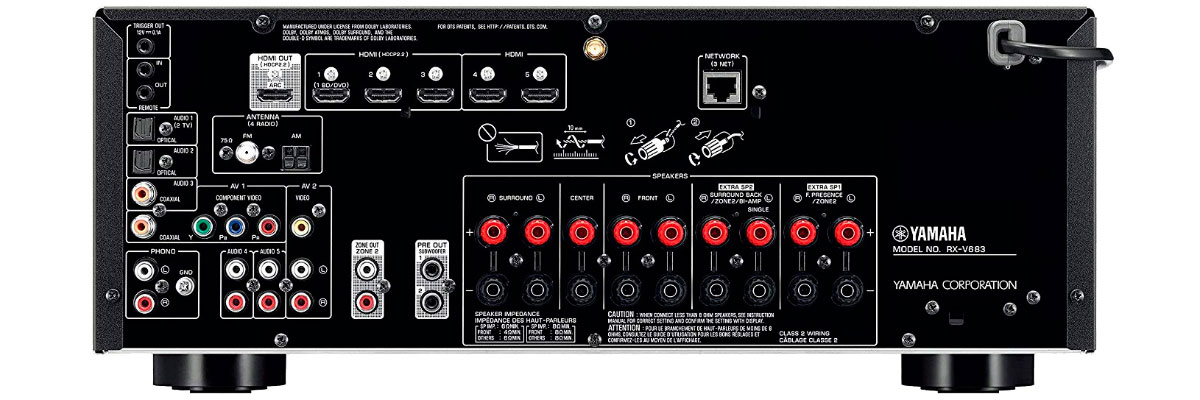
The Yamaha RX-V685 is equipped with the new MusicCast to Surround feature, which allows you to add the MusicCast 50 or MusicCast 20 wireless rear speakers, what not every receiver from this best receiver under 500 comparison can offer. There is also a USB port for playing Hi-Res files (these files can also be read over the network).
Finally, you can control the Yamaha RX-V683 using the supplied remote control or using the Yamaha iOS / Android app. Automatic microphone calibration YPAO (the sound of your system is configured according to the characteristics of your room). The amplifier has fine settings for calibration and ergonomics. Of course, a manual retouching of each parameter is possible in order to customize the reproduction.
Similarly, it is possible to finely set the characteristics of its system, for example by specifying the size of the speakers for the amplifier optimizes its frequency response based on their ability to restore the deep bass. It is quite simple and intuitive to quickly access the desired function or setting.
Key specs
- Channels: 7.2
- Stereo power (RMS), W/Ohm: 90/8, 150/4
- Official website
- Full specs
Pros
- The user interface has a simple structure and is beautifully designed: high resolution allows it to look good on TVs of any size
- The receiver also offers a hefty bass improving, including an Extra Bass enhancement setting
- It is possible to control the receiver through the voice assistant Alexa
Cons
- Managing the receiver without the help of the application is not very convenient
- The network cable is not removable, and in the event of a breakdown, the help of a service center will be required
Sony
Sony STR-DH790
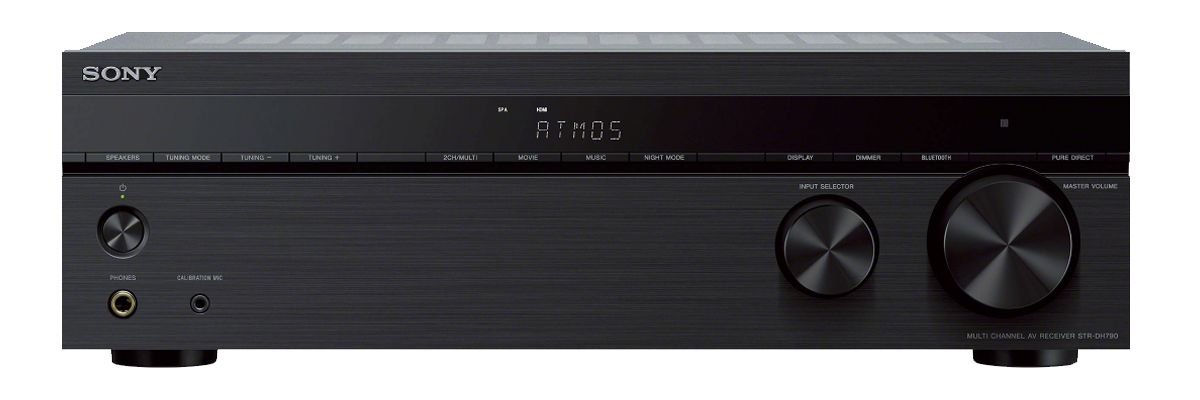
The Sony STR DH790 is an amp that offers the essential to enjoy a quality sound like the best audio receiver under 500. The Sony STR DH790 amplifier works with a home cinema system suitable for medium-sized living rooms with a rather discreet power output that can deliver up to 145 watts.
It is a compact black box, which is suitable for small installations. Its rigid metal frame makes this device robust and offers an interesting sound quality. There is also an oversized transformer. Analog circuits are separated from digital circuits to avoid interference. The interface offers a simple screen with information about the playback track and the name of the channel. All channels and connectors are on the back of the Sony STR DH790.
The amp is a 7.2 channel home cinema amp. It thus makes it possible to build an installation with two lanes in height, in 5.1.2 or in 5.2.2 since it is equipped with two pre-amplified outputs for a subwoofer. It is possible to have a traditional 7.1 installation.
The Sony STR DH790 is also equipped with the automatic calibration system "Digital Cinema Automatic Calibration" or DCAC Ex developed by Sony itself. This acoustic solution allows, through a microphone, to adjust the sound and acoustics according to the configuration of the listening room, while taking into account noises and other parameters that can affect the sound. 
STR DH790 has Bluetooth. It can be connected to a computer or tablet from where you can send your music. An Ethernet port is used to connect to the Internet.
The Sony STR DH790 is compatible with Dolby Atmos and DTS: X immersive multichannel audio formats in a 5.1.2 configuration. These amps can, therefore, be dedicated to the sound reproduction of vertical sound effects. Dolby Surround or DTS: X technologies are available to operate the vertical speakers even without Dolby Atmos or DTS: X audio tracks. The device also supports Dolby Digital Plus, Dolby Digital, Dolby Digital True HD, DTS, and DTS HD Master Audio. The DSD format is decoded from the HDMI inputs.
On the video side, the Sony STR Home Theater Amplifier DH790 has an HDMI input, compatible HDCP 2.2 for the transmission to a TV of all existing streams. Thus, the amp can have a 4K image resolution at 60 frames per second. It also supports HDR10, HLG or Hydra Log Gamma as well as Dolby Vision.
Key specs
- Channels: 7.2
- Stereo power (RMS), W/Ohm: 90/6
- Official website
- Full specs
Pros
- Sound reproduction is optimized with S-Force Pro Surround Surround Virtual Surround technology, which promises to give the illusion of authentic multi-channel sound using just two speakers
Cons
- Sony STR DH790 does not support WiFi
- The receiver does not support the eARC but still remains compatible with Hi-Res audio format
Marantz
Marantz NR1609
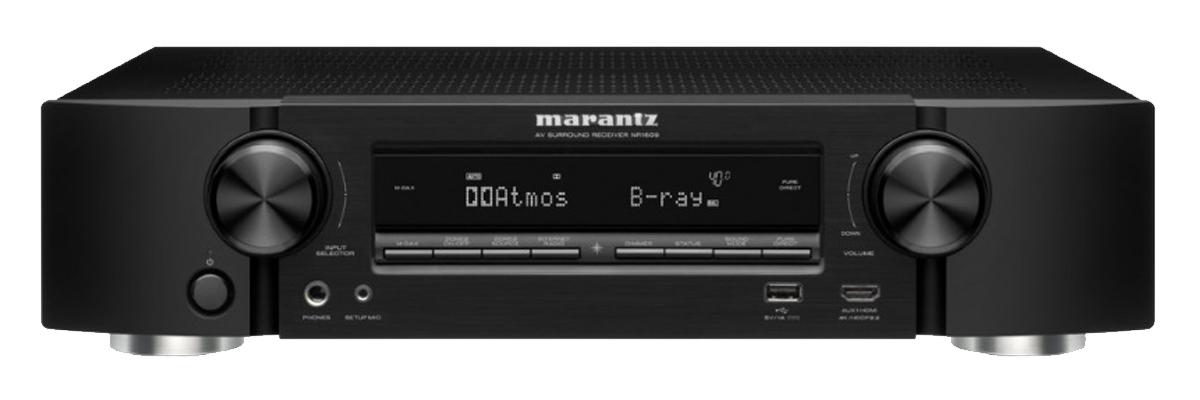
The 7.2-channel Marantz NR1609 AV receiver has a low body and provides a full three-dimensional sound thanks to support for the DTS: X and Dolby Atmos formats in 5.1.2-channel configuration. The model works with the DTS Virtual: X format, which allows you to create an imitation of the sound of ceiling speakers in ordinary surround sound systems that are not equipped with specialized speakers. The receiver also knows how to scale any video to 4K resolution.
The device is equipped with seven discrete amplifiers with high-current transistors at the output, which guarantees a power of 90W per channel at 6 Ohms and allows you to connect speakers with four-ohm impedance. Audyssey MultEQ system is used to set up the speakers in accordance with the geometry and acoustic features of the room. The technology uses Dynamic Volume (normalizes the volume, which is convenient when watching broadcasts with ads) and Dynamic EQ (optimizes the frequency response in order to get full sound in a wide frequency band with full-weight bass even at low volume levels). 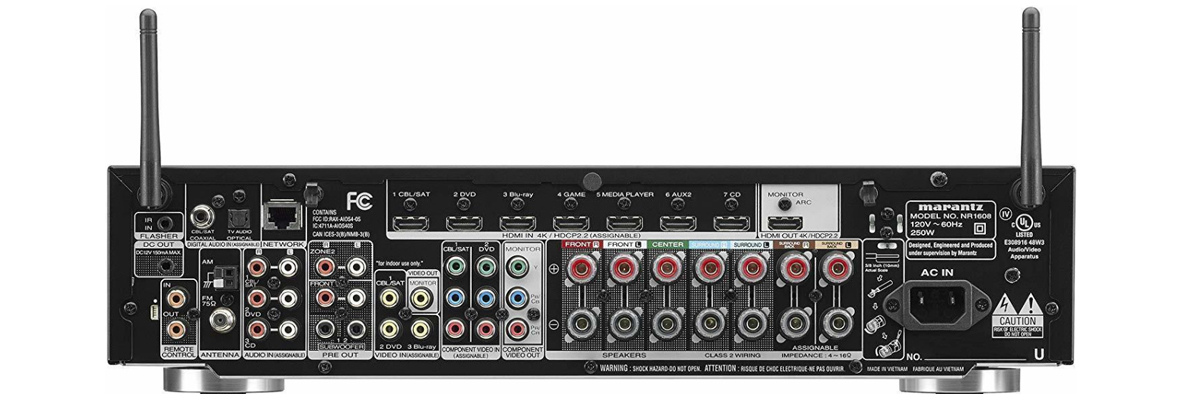
The Marantz NR1609 receiver works reliably on busy wireless networks with dual-band Wi-Fi support. Onboard there is a Bluetooth circuit, and with the release of new software, AirPlay 2 support is announced with the possibility of organizing a multi-room system based on iOS devices. The model copes with the role of a tape drive, playing on a local network, and USB Hi-Res-audio formats (PCM up to 24 bit / 192 kHz and DSD up to 5.6 MHz). Supported online services are Tidal, Deezer, Spotify Connect, TuneIn, etc. The receiver can be used as a hub in the HEOS wireless ecosystem, where all devices are controlled through an application that transmits audio content from local networks, smartphones/tablets, and streaming services to HEOS-compatible components. Thanks to this technology, accurate synchronization of playing the same music in different rooms or the transfer of certain tracks to separate groups of devices are guaranteed. To control the Marantz NR1609, a full-time remote control, a proprietary application, and even Amazon Alexa's personal assistant that accepts voice commands are provided (for this, the HEOS Home Entertainment Skill application must be installed).
The AV receiver has one HDMI input on the front and seven HDMI inputs on the back. All of them support HDCP 2.2 protocol and 4K resolution (60 Hz), as well as HDR10, Dolby Vision, and HLG video standards with extended dynamic range. There is an HDMI output with a return channel and an MM phono equalizer. There are coaxial and optical inputs, 2.2-channel Pre Out and one Pre Out for the second zone. Speakers are connected to seven pairs of screw terminals, each of which is marked with a specific color.
Key specs
- Channels: 7.2
- Stereo power (RMS), W/Ohm: 50/8, 70/6
- Official website
- Full specs
Pros
- My second channel connects to outdoor speakers, which I can now control from my phone using the HEOS or Marantz app. This is very handy not to have to go back inside to change the music, volume, etc
- Helpful manual unlike ones in other brands’ models
Cons
- The only complaint is that the menu pops up when you turn a device on and you have to use the remote to select the input which is already selected
Denon
Denon AVR-S750H
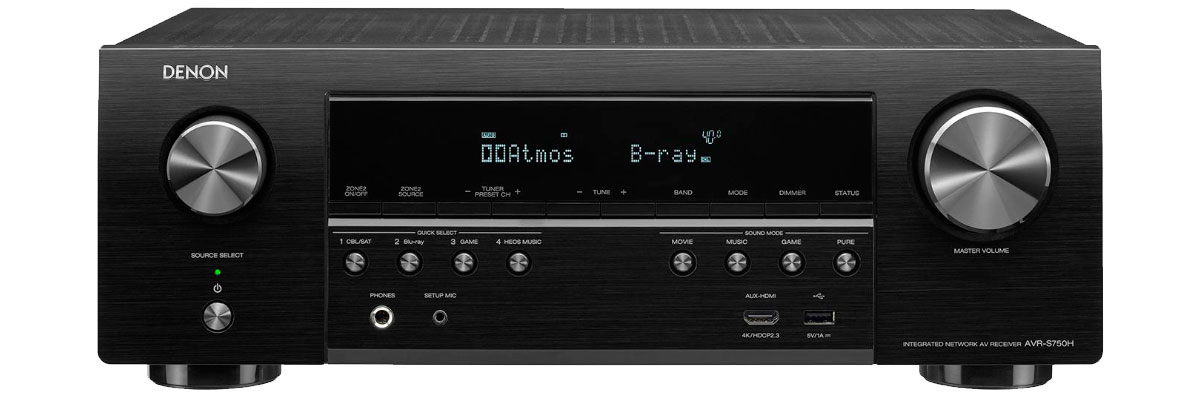
The 7.2-channel Denon AVR-S750H AV receiver takes the golden mean in the new S series, works with 4K Ultra HD resolution, and is equipped with seven discrete high-current amplifiers that provide 140 watts per channel at 6 ohms and can handle even 4 Ohm columns. The receiver supports the main formats of object-oriented 3D sound, including DTS:X and Dolby Atmos in the 5.1.2-channel version. DTS Virtual technologies are available: X and Dolby Atmos Height Virtualization Technology, allowing you to simulate the sound of specialized Atmos speakers or ceiling speakers in 5.2, 7.2, or 2.2-channel systems that are not equipped with such speakers.
For the auto-calibration of the columns, the algorithm of the Audyssey MultEQ system is used. Dynamic Volume and Dynamic EQ technologies are also used to optimize volume and frequency response.
The Denon AVR-S750H receiver is capable of playing audio files, including HD formats FLAC, WAV, and ALAC up to 24 bit / 192 kHz or DSD (2.8 / 5.6 MHz), which are stored on computers / NAS servers on the local network or on external drives connected to USB on the front panel. A web connection provides access to various streaming services, including Spotify Connect, Tidal, TuneIn, Deezer, etc. The receiver supports dual-band Wi-Fi, Bluetooth, and the AirPlay2 protocol, which opens up possibilities for wireless multi-room installation based on Apple devices. 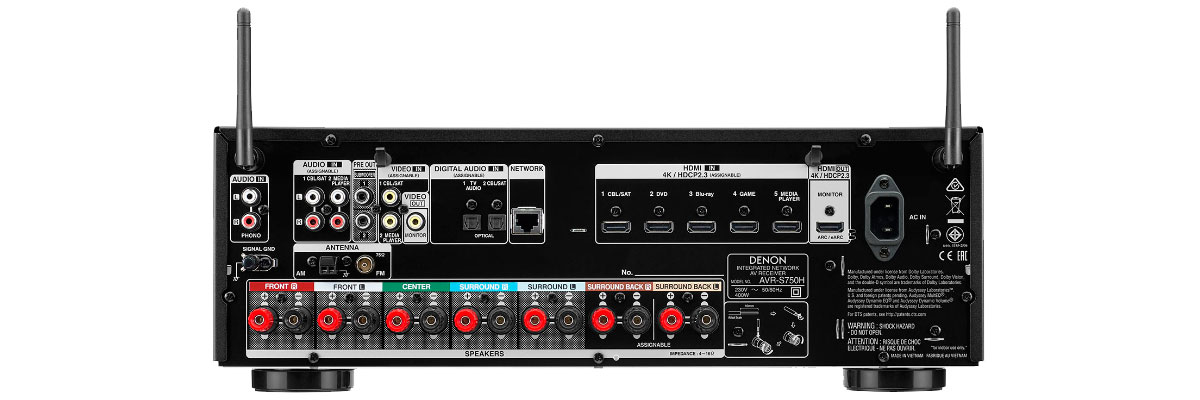
The device feels confident in the HEOS ecosystem, which manages wirelessly and controls all HEOS devices through a single application. You can transfer an audio stream from tablets/smartphones, online services, and local networks to such devices directly from the application. You can play the same composition in different rooms with perfect synchronization or specially selected tracks for each individual room.
The model supports "communication" with personal assistants Apple Siri, Amazon Alexa, and Google Assistant, opening the possibility of voice control of the receiver. You can control in the traditional way using the remote control or application. To configure the receiver, an intuitive Setup Assistant program is used.
Onboard the Denon AVR-S750H, there are six HDMI inputs (one on the front panel) that support 4K Ultra HD / 60 Hz, HDCP 2.3 protocol, and video standards HDR10, Dolby Vision and HLG. There is an HDMI output with support for the extended eARC return channel, which allows you to transfer 3D audio (Dolby Atmos, etc.) to the receiver directly from the TV panel. Among another switching, the presence of the input of the MM phono stage can be distinguished. To connect the speakers are seven pairs of screw terminals, indicated in different colors.
Key specs
- Channels: 7.2
- Stereo power (RMS), W/Ohm: 75/8, 110/6
- Official website
- Full specs
Pros
- The AVR-S750H capable of reproducing 24 bit / 192 kHz stream and DSD
- Denon AVR-S750H can be controlled using Alexa, and also works with Google Assistant / Google Home
Cons
- The receiver does not scale input images to Ultra HD resolution
Denon AVR-S940H
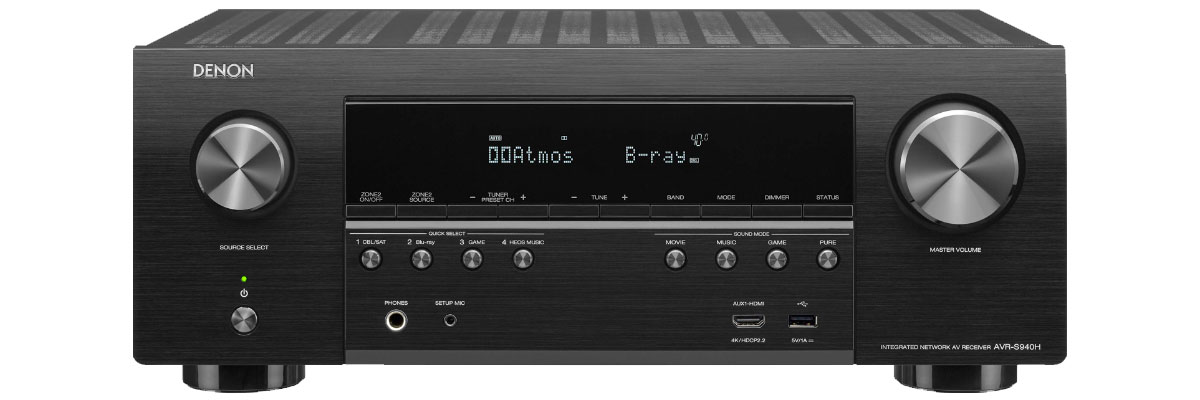
The design of the AVR-S940H is traditional for Denon's receivers. And since the receiver does not surprise us with its appearance, we turn our attention to the internal components.
Under the black case, the unit is equipped with discrete power amplifiers as well as with a 32-bit AKM DAC.
Due to the good build, this best av receiver under 500 capable of delivering up to 80 watts in stereo and 145 watts in peak. Like most modern models, this device supports all the latest audio formats with Dolby Atmos and DTS: X, but also comes with DTS Virtual: X technology, which is an upmix technology that gives the illusion of overhead sounds without the need for real speakers. Also, another build feature positively affects the sound of the receiver - the presence of an additional 2 subwoofer ports, with which the AVR-S940H is able to provide the necessary power for any type of audio room. 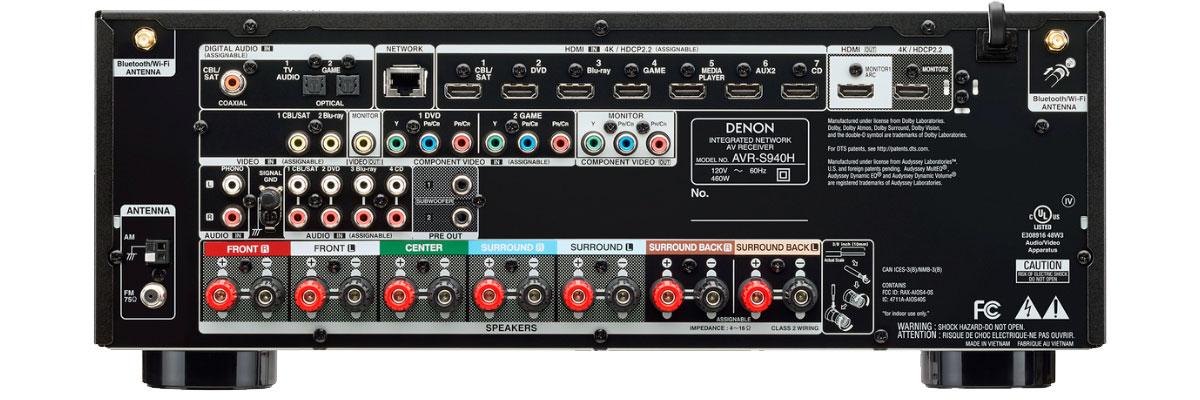
On the basis of the device, it is possible to create surround sound configurations from 5.1 to a complete system supporting Dolby Atmos 5.2.2 with two subwoofers and 2 top speakers for height layer effects.
And do not forget about the excellent features of video output. The receiver has full support for 4K / 60 FPS resolution in HDR mode, with all top video features, such as 4:4:4 color resolution, HDR and BT.2020, plus Dolby Vision compatibility and Hybrid Log-Gamma (HLG), making this device a great home theater receiver.
Key specs
- Channels: 7.2
- Stereo power (RMS), W/Ohm: 90/8, 125/6
- Official website
- Full specs
Pros
- The AVR-S750H capable of reproducing 24 bit / 192 kHz stream and DSD
- Denon AVR-S750H can be controlled using Alexa, and also works with Google Assistant / Google Home
Cons
- The receiver does not scale input images to Ultra HD resolution
Pioneer
Pioneer VSX-LX303
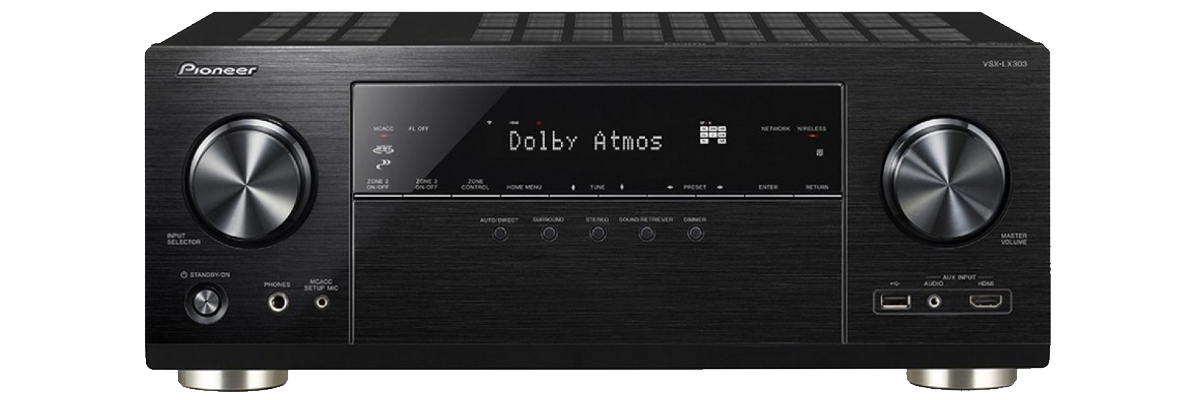
This home theater receiver under 500 is able to receive and process all conceivable streams of digital and analog audio content in the house, as well as voice the entire apartment or cottage with the help of built-in amplifiers. Even a brief description of the device’s capabilities is dumbfounded: as if they put together various catalogs in a heap and sprinkled with fantastic literature. Then it’s already difficult to understand whether it is a cinema receiver with “streaming-multi-room” functionality or vice versa.
But in appearance, it is a classic AV receiver. Even too classic. Some collective image without a single memorable detail. On the other hand, you are guaranteed to have no aesthetic contradictions when installing the Pioneer VSX-LX303 in a rack with any other equipment. There are two options to choose from - black and silver.
To control the network arsenal requires a smartphone or tablet. Everything else is controlled from a simple, but completely ergonomic complete remote control. All the basic indications, according to tradition, are displayed on the display of the device, and the exact settings are made through the on-screen menu. By the way, the graphics are very nice. 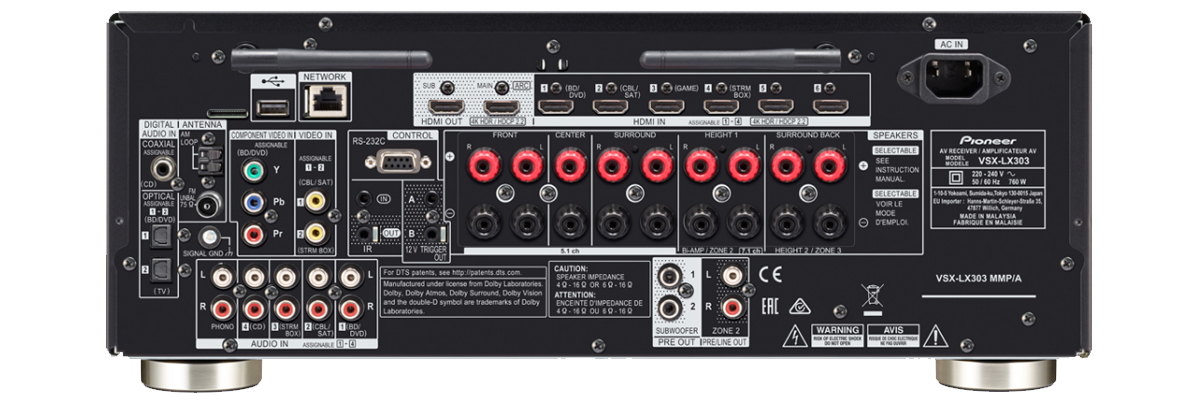
The amplifier section of the receiver is organized quite traditionally: transistor amplification of class AB with convection cooling through a large radiator. For emergency situations (very high volume or very high room temperature), a 12 cm exhaust fan is provided under the top cover of the case. During the tests, it did not turn on even once, but its presence definitely inspires confidence.
The stated return of 170 watts per channel, as you might guess, is a “marketing" value. Because it is achieved only on a 1 kHz sine wave when loading one channel until the level of harmonic distortion reaches 1%.
And there is a bi-amp for the front speaker pair. In combination with the tremendous ability to play music from a USB stick (up to FLAC 384 kHz and DSD 5.6 MHz) or via a wired/wireless local area network (almost all formats are supported, except for the most high-bitrate ones), as well as a very good built-in digital-analog converter Ti BurrBrown PCM 5101 on the front channels (in multi-channel mode, the AKM4458 DAC helps him), we get an unexpectedly decent basis for a stereo system.
Test auditions left no doubt in the competencies of the Pioneer VSX-LX303. For a middle-class cinema, it is suitable without any restrictions. Unless we advise you to choose acoustics with a sensitivity of over 90 dB and resistance of 4-6 Ohms if your listening room has an area of more than 30 sq.m, then, even in a 40-meter room, without undue distortion, it will be possible to provide sound pressure as in a commercial cinema, and there will still be a margin of volume.
And in terms of stereo sound, there were no serious complaints. Especially if you start the front pair using bi-amp and turn on the “direct” sound mode bypassing the processions. It turns out not just "normal", but very exciting and lively! Volume, sound resolution, and even dynamics - all at a decent level.
Key specs
- Channels: 9.2
- Stereo power (RMS), W/Ohm: 100/8, 200/6
- Full specs
Pros
- The rich equipment, sound quality (including stereo) and real power output do not disappoint
- By the way, the graphics in the menu are very nice
Cons
- No support for aptX codec for bluetooth
-

Denon AVR-S540BT
- Denon
- | 400
- 1128
-
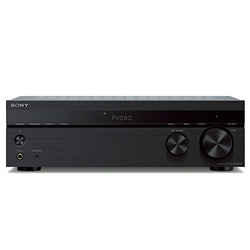
Sony STR-DH190
- Sony
- | 200
- 1970
-
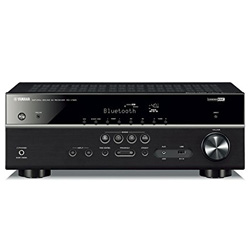
Yamaha RX-V385
- Yamaha
- | 300
- 1015
-
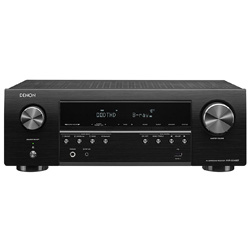
Denon AVR-X540BT
- Denon
- | 300
- 1128
-
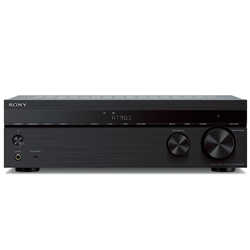
Sony STR-DH790
- Sony
- | 400
- 713
-

Yamaha RX-V385BL
- Yamaha
- | 300
- 1164
-
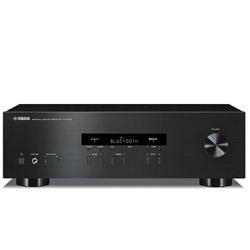
Yamaha R-S202BL
- Yamaha
- | 200
- 2643
-

Cambridge Audio AXR100
- Cambridge Audio
- | 500
- 37
-
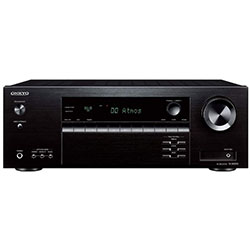
Onkyo TX-SR393
- Onkyo
- | 400
- 46
-
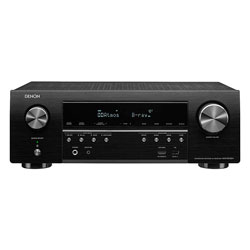
Denon AVR-S750H
- Denon
- | 500
- 201
-
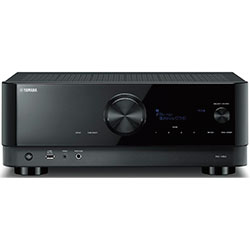
Yamaha RX-V4A
- Yamaha
- | 500
- 6
-
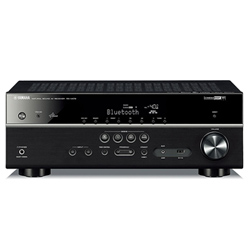
Yamaha RX-V479BL
- Yamaha
- | 500
- 116
-
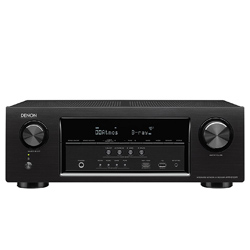
Denon AVR-S720W
- Denon
- | 500
- 185
-
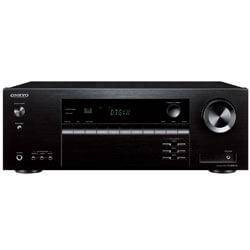
Onkyo TX-NR5100
- Onkyo
- | 500
-
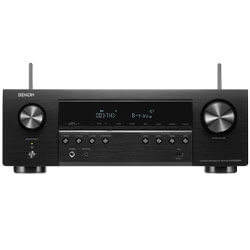
Denon AVR-S660H
- Denon
- | 500
-
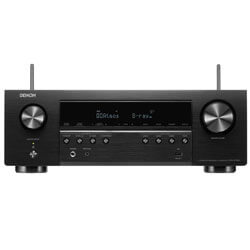
Denon AVR-S760H
- Denon
- | 500
Popular receiver comparisons
Recent reviews
